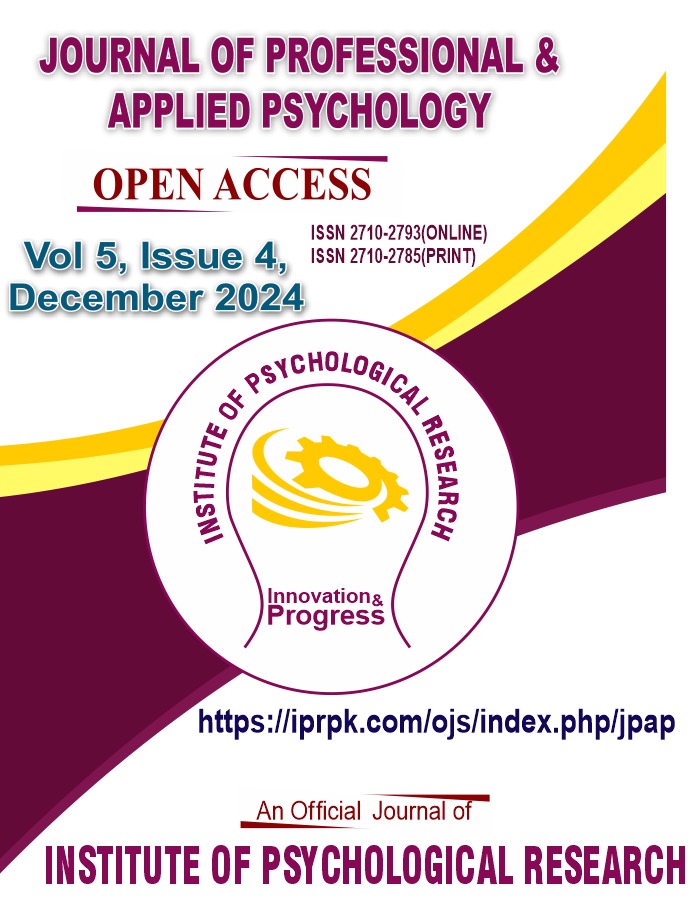Pain Severity, Illness Appraisal and Pain Acceptance in Patients with Chronic Pain Conditions
DOI:
https://doi.org/10.52053/jpap.v5i4.314Keywords:
Chronic Pain Conditions, Illness Appraisal, Pain Acceptance, Pain SeverityAbstract
The present study used a correlational research design to look into the association across pain severity (PS), illness appraisal (IA) and pain acceptance (PA) among individuals struggling with chronic pain. A purposive sample of 120 chronic pain patients from the Outpatient Departments of both private and government tertiary care hospitals of Lahore was obtained. The participants were asked to fill out a questionnaire booklet including a demographic questionnaire, West Haven Yale Multidimensional Pain Inventory, Revised Illness Perception Questionnaire, and Chronic Pain Acceptance Questionnaire. The findings revealed significant associations between pain severity, its subscales and pain acceptance. Timeline, consequences and emotional representations and pain acceptance; treatment control and illness coherence and pain acceptance showed negative correlation. Emotional representation predicted PA and pain willingness; Consequences, Timeline cyclic, affective distress and interference predicted both PA and Activity engagement; Treatment control and distracting responses were better predictors of pain willingness and negative responses was a better predictor for activity engagement. Independent sample t-test indicated that women tend to keep themselves busy with household chores whereas men tend to experience pain with more negative consequences. It was concluded that those who appraised their illness positively showed more acceptance towards their diagnosis and displaying better life regulation. Overall, it was concluded that pain acceptance plays a significant role in the lives of individuals with chronic pain. Hence, the results can be used to enhance empathy among clinical psychologists.
References
Andrasik, F., Goodie, J. L., & Peterson, A. L. (2015). Biopsychosocial assessment in Clinical Health Psychology. The Guilford Press. https://psycnet.apa.org/record/2015-10562-000
Arat, S., Rassart, J., Moons, P., Luyckx, K., Vandenberghe, J., & Westhovens, R. (2018). Prospective associations between illness perceptions and health outcomes in patients with systemic sclerosis and systemic lupus erythematosus: a cross-lagged analysis. Rheumatology Advances in Practice, 2(1). https://doi.org/10.1093/rap/rky007
Barriers to Physical Activity. (2022, October 26).Physiopedia. https://www.physiopedia.com/Barriers_to_Physical_Activity
Boutevillain, L., Dupeyron, A., Rouch, C., Richard, E., & Coudeyre, E. (2017). Facilitators and barriers to physical activity in people with chronic low back pain: A qualitative study. PLoS ONE, 12(7). https://doi.org/10.1371/journal.pone.0179826
Brannon, L., Updegraff, J. A., & Feist, J. (2021). Health Psychology: An Introduction to Behavior and Health (10th ed.). Cengage.
Chapman, N., Broadbent, S., & Coutts, R. (2019). Acceptance, fatigue severity and self-reported physical activity in individuals with chronic fatigue syndrome/myalgic encephalomyelitis. Fatigue: Biomedicine, Health & Behavior, 7(2), 102-115.https://doi.org/10.1080/21641846.2019.1629760
Chiros, C., & O’Brien, W. H. (2011). Acceptance, appraisals, and coping in relation to migraine headache: an evaluation of interrelationships using daily diary methods. Journal of Behavioral Medicine, 34(4), 307–320. https://doi.org/10.1007/s10865-011-9313-0
Collingwood, M. J. (2008). Pain stages of change: Variations in pain acceptance, catastrophizing, and emotional distress across a model of readiness for behavior change. https://scholarworks.uni.edu/cgi/viewcontent.cgi?article=1585&context=etd
Croft, P., Blyth, F. M., & Van Der Windt, D. (2010). Chronic Pain Epidemiology: From Aetiology to Public Health. https://doi.org/10.1093/acprof:oso/9780199235766.001.0001
Fatoye, F., Gebrye, T., & Odeyemi, I. (2019). Real-world incidence and prevalence of low back pain using routinely collected data. Rheumatology International, 39(4), 619-626. https://doi.org/10.1007/s00296-019-04273-0
Fernández-De-Las-Peñas, C. (2014). Craniofacial neuralgia. In Encyclopedia of the Neurological Sciences (2nd ed., pp. 890–893). Elsevier. https://doi.org/10.1016/b978-0-12-385157-4.00227-x
Fish, R., Hogan, M., Morrison, T., Stewart, I., & McGuire, B. (2013). Willing and Able: A Closer Look at Pain Willingness and Activity Engagement on the Chronic Pain Acceptance Questionnaire (CPAQ-8). The Journal of Pain, 14(3), 233-245.https://doi.org/10.1016/j.jpain.2012.11.004
Gatchel, R. J., & Schultz, I. Z. (2014). Handbook of Musculoskeletal Pain and Disability Disorders in the Workplace. In Handbooks in health, work, and disability. https://doi.org/10.1007/978-1-4939-0612-3
Goldberg, D., & McGee, S. (2011). Pain as a global public health priority. BMC Public Health, 11(1). https://doi.org/10.1186/1471-2458-11-770
Gureje, O., Von Korff, M., Kola, L., Demyttenaere, K., He, Y., Posada-Villa, J., Lepine, J. P., Angermeyer, M. C., Levinson, D., De Girolamo, G., Iwata, N., Karam, A., Borges, G. L. G., De Graaf, R., Browne, M. O., Stein, D. J., Haro, J. M., Bromet, E. J., Kessler, R. C., & Alonso, J. (2007). The relation between multiple pains and mental disorders: Results from the World Mental Health Surveys. Pain, 135(1), 82–91. https://doi.org/10.1016/j.pain.2007.05.005
Henderson, J. V., Harrison, C. M., Britt, H. C., Bayram, C. F., & Miller, G. C. (2013). Prevalence, causes, severity, impact, and management of chronic pain in Australian general practice patients. Pain Medicine (Malden, Mass.), 14(9), 1346–1361. https://doi.org/10.1111/pme.12195
Jackson, T., Wang, Y., & Fan, H. (2014). Associations Between Pain Appraisals and Pain Outcomes: Meta-Analyses of Laboratory Pain and Chronic Pain Literatures. The Journal Of Pain, 15(6), 586-601. https://doi.org/10.1016/j.jpain.2014.01.499
Järemo, P., Arman, M., Gerdle, B., Larsson, B., & Gottberg, K. (2017). Illness beliefs among patients with chronic widespread pain - associations with self-reported health status, anxiety and depressive symptoms and impact of pain. BMC Psychology, 5(1). https://doi.org/10.1186/s40359-017-0192-1
Kaye, A. D., & Urman, R. D. (2011). Understanding pain: What You Need to Know to Take Control. Praeger.
Kerns, R. D., Turk, D. C., & Rudy, T. E. (1985). The West Haven-Yale Multidimensional Pain Inventory (WHYMPI). Pain, 23(4), 345–356. https://doi.org/10.1016/0304-3959(85)90004-1
Kleinman, A., Eisenberg, L., & Good, B. (1978). Culture, illness, and care: clinical lessons from anthropologic and cross-cultural research. Annals of Internal Medicine, 88, 251–8.
Kratz, A. L., Ehde, D. M., Bombardier, C. H., Kalpakjian, C. Z., & Hanks, R. A. (2016). Pain acceptance decouples the momentary associations between pain, pain interference, and physical activity in the daily lives of people with chronic pain and spinal cord injury. Journal of Pain, 18(3), 319–331. https://doi.org/10.1016/j.jpain.2016.11.006
LaChapelle, D., Lavoie, S., & Boudreau, A. (2008). The Meaning and Process of Pain Acceptance. Perceptions of Women Living with Arthritis and Fibromyalgia. Pain Research and Management, 13(3), 201-210. https://doi.org/10.1155/2008/258542
Leventhal, H., Diefenbach, M. A., & Leventhal, E. A. (1992). Illness cognition: Using common sense to understand treatment adherence and affect cognition interactions. Cognitive Therapy and Research, 16(2), 143–163.
Leventhal, H., Leventhal, E.A. and Cameron, L. (2001) Representations, procedures, and affect in illness self- regulation: A perceptual-cognitive model. In: Baum, A., Revenson, T.A. and Singer, J.E., Eds., Handbook of Health Psychology. Lawrence Erlbaum, Mahwah, 19-48.
Lubkin, I. M., & Larsen, P. D. (2013). Chronic illness: Impact and Intervention. Jones & Bartlett Publishers.
Lumley, M., Cohen, J., Borszcz, G., Cano, A., Radcliffe, A., & Porter, L. et al. (2011). Pain and emotion: a biopsychosocial review of recent research. Journal Of Clinical Psychology, 67(9), 942-968. https://doi.org/10.1002/jclp.20816
McCracken, L., & Eccleston, C. (2003). Coping or acceptance: what to do about chronic pain? Pain, 105(1), 197-204. https://doi.org/10.1016/s0304-3959(03)00202-1
McCracken, L., & Samuel, V. (2007). The role of avoidance, pacing, and other activity patterns in chronic pain. Pain, 130(1), 119-125. https://doi.org/10.1016/j.pain.2006.11.016
McManimen, S., McClellan, D., Stoothoff, J., Gleason, K., & Jason, L. A. (2019). Dismissing chronic illness: A qualitative analysis of negative health care experiences. Health Care for Women International, 40(3), 241–258. https://doi.org/10.1080/07399332.2018.1521811
Moore, H., McGuire, B., Stewart, I., Barnes-Holmes, D., & Barnes-Holmes, Y. (2015). Comparison of acceptance and distraction strategies in coping with experimentally induced pain. Journal of Pain Research, 139. https://doi.org/10.2147/jpr.s58559
Moss-Morris, R., Weinman, J., Petrie, K., Horne, R., Cameron, L., & Buick, D. (2002). The Revised Illness Perception Questionnaire (IPQ-R). Psychology and Health, 17(1), 1–16. https://doi.org/10.1080/08870440290001494
O’Donohue, W., & Tolle, L. W. (2009). Introduction. In Springer eBooks (pp. 3–6). https://doi.org/10.1007/978-0-387-87687-0_1
Ogden. (2018). The Psychology of Health and Illness: An Open Access Course. https://my.uopeople.edu/pluginfile.php/57436/mod_book/chapter/160034/PSYC1111.Ogden.Psychology.of.Health.and.Illness.pdf
Tirodkar, M., Baker, D., Makoul, G., Khurana, N., Paracha, M., & Kandula, N. (2010). Explanatory Models of Health and Disease Among South Asian Immigrants in Chicago. Journal of Immigrant and Minority Health, 13(2), 385-394. https://doi.org/10.1007/s10903-009-9304-1
Titus, C. A., & Biggs, H. C. (2016). ‘Well, This is it. Just Get on With it’: Pain Willingness and Activity Engagement in People with Chronic Pain. Australian Journal of Rehabilitation Counselling, 22(1), 13–26. https://doi.org/10.1017/jrc.2016.5
Treede, R., Rief, W., Barke, A., Aziz, Q., Bennett, M. I., Benoliel, R., Cohen, M., Evers, S., Finnerup, N. B., First, M. B., Giamberardino, M. A., Kaasa, S., Kosek, E., Lavand’homme, P., Nicholas, M., Perrot, S., Scholz, J., Schug, S., Smith, B. H., . . . Wang, S. (2015). A classification of chronic pain for ICD-11. Pain, 156(6), 1003–1007. https://doi.org/10.1097/j.pain.0000000000000160
Trigeminal Neuralgia. (2024). National Institute of Neurological Disorders and Stroke. https://www.ninds.nih.gov/health-information/disorders/trigeminal-neuralgia
Ünal, Ö. (2019). The relationship of illness perceptions with demographic features, pain severity, functional capacity, disability, depression, and quality of life in patients with chronic low back pain. Turkish Journal of Physical Medicine and Rehabilitation, 65(4), 301–308. https://doi.org/10.5606/tftrd.2019.3248
Vowles, K. E., McCracken, L. M., McLeod, C., & Eccleston, C. (2008). The Chronic Pain Acceptance Questionnaire: Confirmatory factor analysis and identification of patient subgroups. Pain, 140(2), 284–291. https://doi.org/10.1016/j.pain.2008.08.012
Vowles, K., Fink, B., & Cohen, L. (2014). Acceptance and Commitment Therapy for chronic pain: a diary study of treatment pocess and relation to reliable change in disability. The Journal of Pain, 15(4), S111. https://doi.org/10.1016/j.jcbs.2014.04.003
Downloads
Published
How to Cite
Issue
Section
Categories
License
Copyright (c) 2025 Khola Tahir, Humaira Naz, Iman Amir Sheikh

This work is licensed under a Creative Commons Attribution-NonCommercial 4.0 International License.
Creative Commons Attribution-Non Commercial 4.0 International (CC BY-NC 4.0) License: This article is distributed under the terms of the Creative Commons Attribution-Non Commercial 4.0 International License (https://www.creativecommons.org/licenses/by-nc/4.0/) which permits non-Commercial use, reproduction and distribution of the work without further permission provided the original work is attributed as specified on the Journal website at (https://iprpk.com/ojs/index.php/jpap)












